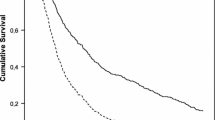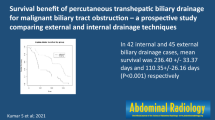Abstract
Purpose
Biliary tract obstruction in cancer patients is usually associated with a poor prognosis. The obstruction may cause distressing symptoms, such as pruritus. As this situation occurs mostly in advanced cancer, the primary objective of the treatment is in many cases symptom control and not prolonging life. However, some patients can be candidates for chemotherapy. To see the outcomes of stenting insertion in patients of our oncology center.
Methods
A retrospective study of patients who have undergone this procedure between 1 October 2011 and 31 December 2018 was carried out.
Results
Insertion of a biliary stent was performed in 171 patients. The most common diagnoses were gastric and colorectal cancers, each with 42 (24%), followed by pancreatic (34 (20%)) and biliary tract cancer (25 (14%)). Most stents (155 (91%)) were placed percutaneously. Complications were seen in 91 (53%) patients and the most common was cholangitis in 48 (53%) patients, and the median survival was 75.5 days (3–1246). A total of 168 (98%) patients were referred to palliative care. In a multivariable analysis, the ECOG performance status was associated with survival, with the ECOG 0, 1, and 2 associated with better survival and peritoneal metastases associated with lower survival.
Conclusions
For many patients with advanced cancers, it may not be clear if the benefits of palliative biliary stents outweigh the risks. Therefore, the problem should be discussed with the patients and their families, making clear the goals of care and the potential benefits and risks that can be expected.

Similar content being viewed by others
References
Tsetisa D, Krokidisb M, Negruc D, Prassopoulosd P. Malignant biliary obstruction: the current role of intervention radiology. Ann Gastroenterol. 2016;29:33–6.
Boulay BR, Birg A. Malignant biliary obstruction: from palliation to treatment. World J Gastrointest Oncol. 2016;8:498–508.
Bassari R, Koea JB. Jaundice associated pruritus: a review of pathophysiology and treatment. World J Gastroenterol. 2015;21:1404–13.
Moy BT, Birk JW. An update to hepatobiliary stents. J Clin Transl Hepatol. 2015;3:67–77.
Naggar E, Krag E, Matzen P. Endoscopically inserted biliary endoprosthesis in malignant obstructive jaundice - a survey of the literature. Liver. 1990;10:321–4.
Lee BH, Chin SY, Kim SA, Kim KH, Do YS. Obstructive jaundice in gastric carcinoma: cause, site, and relationship to the primary lesion. Abdom Imaging. 1995;20:307–11.
Moon SG, Han JK, Kim TK, Kim AY, Kim TJ, Choi BI. Biliary obstruction in metastatic disease: thin-section helical CT findings. Abdom Imaging. 2003;28:45–52.
Iwasaki M, Furuse J, Yoshino M, Konishi M, Kawano N, Kinoshita T, et al. Percutaneous transhepatic biliary drainage for the treatment of obstructive jaundice caused by metastases from nonbiliary and nonpancreatic cancers. Jpn J Clin Oncol. 1996;26:465–8.
van Delden OM, Laméris JS. Percutaneous drainage and stenting for palliation of malignant bile duct obstruction. Eur Radiol. 2008;18:448–56.
Dumonceau JM, Tringali A, Blero D, Devière J, Laugiers R, Heresbach D, et al. Biliary stenting: indications, choice of stents and results: European Society of Gastrointestinal Endoscopy (ESGE) clinical guideline. Endoscopy. 2012;44:277–92.
Pereira-Lima JC, Jakobs R, Maier M, Benz C, Kohler B, Riemann JF. Endoscopic biliary stenting for the palliation of pancreatic cancer: results, survival predicative factors, and comparison of 10-French with 11.5-French gauge stents. Am J Gastroenterol. 1996;91:2179–84.
van den Bosch RP, van der Schelling GP, Klinkenbijl JHG, Mulder PGH, van Blankenstein M, Jeekel J. Guidelines for the application of surgery and endoprostheses in the palliation of obstructive jaundice in advanced cancer of the pancreas. Ann Surg. 1994;219:18–24.
Speer AG, Cotton PB, Russell RC, Mason RR, Hatfield AR, Leung JW, et al. Randomised trial of endoscopic versus percutaneous stent insertion in malignant obstructive jaundice. Lancet. 1987;2(8550):57–62.
Piñol V, Castells A, Bordas JM, Real MI, Llach J, Montañà X, et al. Percutaneous self-expanding metal stents versus endoscopic polyethylene endoprostheses for treating malignant biliary obstruction: randomized clinical trial. Radiology. 2002;225:27–34.
Ciambella CC, Beard RE, Miner TJ. Current role of palliative interventions in advanced pancreatic cancer. World J Gastrointest Surg. 2018;10:75–83.
Dumonceau JM, Tringali A, Papanikolaou IS, Blero D, Mangiavillano B, Schmidt A, et al. Endoscopic biliary stenting: indications, choice of stents, and results: European Society of Gastrointestinal Endoscopy (ESGE) Clinical Guideline - Updated October 2017. Endoscopy. 2018;50:910–30.
Andersen JR, Sorensen SM, Kruse A, Rokkjaer M, Matzen P. Randomised trial of endoscopic endoprosthesis versus operative bypass in malignant obstructive jaundice. Gut. 1989;30:1132–5.
Heedman PA, Åstradsson E, Blomquist K, Sjödahl R. Palliation of malignant biliary obstruction: adverse events are common after percutaneous transhepatic biliary drainage. Scand J Surg. 2018;107:48–53.
Sut M, Kennedy R, McNamee J, Collins A, Clements B. Long-term results of percutaneous transhepatic cholangiographic drainage for palliation of malignant biliary obstruction. J Palliat Med. 2010;13:1311–3.
Catalano O, De Bellis M, Sandomenico F, di Castelguidone EL, Delrio P, Petrillo A. Complications of biliary and gastrointestinal stents: MDCT of the cancer patient. AJR. 2012;198:W1–W10.
Dy SM, Harman SM, Braun UK, Howie LJ, Harris PF, Jayes RL. To stent or not to stent: an evidence-based approach to palliative procedures at the end of life. J Pain Symptom Manag. 2012;43:795–801.
Acknowledgments
This work was supported in part by the North Section of the Portuguese League against Cancer.
Author information
Authors and Affiliations
Corresponding author
Ethics declarations
The study was approved by the Ethics Committee of the hospital.
Conflict of Interest
The authors declare that they have no conflict of interest.
Additional information
Publisher’s Note
Springer Nature remains neutral with regard to jurisdictional claims in published maps and institutional affiliations.
Rights and permissions
About this article
Cite this article
Ferraz Gonçalves, J.A., Rosendo, E., Sousa, L. et al. Complications of Biliary Drainage in Patients with Malignant Biliary Obstruction. J Gastrointest Canc 52, 1067–1072 (2021). https://doi.org/10.1007/s12029-020-00541-6
Accepted:
Published:
Issue Date:
DOI: https://doi.org/10.1007/s12029-020-00541-6




